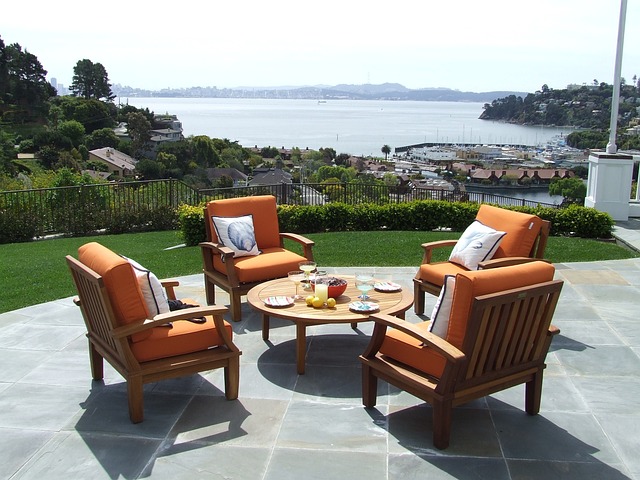Outdoor furniture is a great way to enjoy the outdoors and create an inviting space for family and friends to gather. However, as with any outdoor item, outdoor furniture is exposed to the elements, including moisture. This raises the question: can outdoor furniture get wet?
Yes, outdoor furniture can get wet, but its ability to withstand moisture depends on the materials used, design, location, and climate. Choosing furniture made from water-resistant materials and protecting it from moisture through proper maintenance and care can help prolong its lifespan and prevent damage caused by moisture.
However, the answer is not a simple yes or no, as it depends on the materials used, the design of the furniture, and other factors. In this article, I will explore the effects of moisture on outdoor furniture, factors that affect its ability to get wet, how to choose outdoor furniture that can withstand moisture and tips for caring for furniture that gets wet. By understanding the relationship between outdoor furniture and moisture, you can make informed decisions about selecting, using, and maintaining your outdoor furniture.
Materials Used in Outdoor Furniture
A key factor in determining whether outdoor furniture can get wet is the materials used to construct it. Here are some common materials used in outdoor furniture and how they react to moisture:
- Wood: Wood is a popular material for outdoor furniture because of its natural beauty and durability. However, it is susceptible to moisture and can swell, warp, and rot if not treated properly. Teak and cedar are two types of wood that are naturally resistant to moisture.
- Metal: Metal furniture, such as wrought iron or aluminum, is generally resistant to moisture and can withstand rain and humidity. However, some metals can rust or corrode over time if not properly protected.
- Plastic: Plastic or resin furniture is often inexpensive and lightweight, making it a popular choice for outdoor use. It is generally resistant to moisture and can be left outside in the rain without any damage.
- Wicker: Wicker furniture is made from natural materials, such as rattan or bamboo, and is often treated with a waterproof coating. However, it is still susceptible to moisture and can rot if not properly cared for.
- Fabric: Outdoor furniture cushions and upholstery are often made from synthetic fabrics that are designed to be resistant to moisture and mildew. However, it is still important to remove cushions and store them in a dry place during extended periods of rain.
Effects of Moisture on Outdoor Furniture
Moisture can have a variety of negative effects on outdoor furniture, regardless of the material used. Here are some potential issues caused by moisture:
- Warping: Moisture can cause wood to warp or bend, making furniture unstable and uncomfortable to sit on.
- Rot: Prolonged exposure to moisture can cause wood to rot, which can lead to structural damage and make the furniture unsafe to use.
- Rust and corrosion: Metal furniture can rust or corrode over time if not properly protected from moisture. This can weaken the furniture and make it less visually appealing.
- Mildew and mold: Moisture can create a breeding ground for mildew and mold, which can stain and damage fabric upholstery and cushions.
- Discoloration: Over time, exposure to moisture can cause furniture to fade or discolor, especially if it is made from natural materials such as wood or wicker.
To prevent these issues, it is important to take steps to protect your outdoor furniture from moisture and to choose materials that are resistant to water damage.
Factors That Affect Outdoor Furniture’s Ability to Get Wet
The ability of outdoor furniture to get wet can be affected by a number of factors, including:
- Design of furniture: The design of outdoor furniture can affect its ability to withstand moisture. For example, furniture with slatted or open designs allows water to drain away quickly, reducing the risk of moisture damage.
- Location of furniture: Where you place your outdoor furniture can also affect its exposure to moisture. Furniture placed under a covered patio or awning is less likely to get wet than furniture placed in an open area.
- Climate and weather conditions: The amount of moisture your outdoor furniture is exposed to will depend on your local climate and weather conditions. Areas with high humidity, frequent rain, or snowfall will require furniture that is more resistant to moisture.
- Maintenance and care: Regular maintenance and care can also affect the ability of outdoor furniture to get wet. Furniture that is regularly cleaned and protected from the elements is more likely to withstand moisture than furniture that is neglected.
Choosing Outdoor Furniture That Can Get Wet
Choosing outdoor furniture that can withstand moisture is essential if you want to ensure that it lasts for years to come. Here are five tips for selecting outdoor furniture that can get wet:
- Look for waterproof or water-resistant materials: Choose furniture made from materials that are designed to withstand moisture, such as teak, cedar, wrought iron, aluminum, or plastic.
- Check the construction: Look for furniture with tight joints and seams, as these will prevent water from seeping in and causing damage.
- Consider the design: Look for furniture with slatted or open designs, which allow water to drain away quickly, reducing the risk of moisture damage.
- Choose the right cushions: If you plan to use cushions or fabric upholstery, choose materials that are designed to be resistant to moisture and mildew. Remove cushions and store them in a dry place during extended periods of rain.
- Invest in furniture covers: Use furniture covers during periods of extended rain or when the furniture is not in use. Covers can protect furniture from moisture and other weather-related damage.
Caring for Outdoor Furniture That Gets Wet
Caring for outdoor furniture that gets wet is essential to prolong its lifespan and keep it looking its best. Here are 5 tips for cleaning and protecting outdoor furniture that gets wet:
- Clean regularly: Regular cleaning is essential to prevent dirt, grime, and mildew buildup on your furniture. Use a soft-bristled brush and mild soap to clean your furniture, and rinse thoroughly with water.
- Dry thoroughly: After cleaning, make sure to dry your furniture completely to prevent moisture from building up. Wipe down furniture with a clean, dry cloth or allow it to air dry completely before using it.
- Apply a protective coating: Use a protective coating, such as a sealant or waterproofing spray, to help protect your furniture from moisture damage. Make sure to choose a product that is specifically designed for the material of your furniture.
- Store properly: During periods of extended rain or when the furniture is not in use, store your furniture in a dry, protected area. This will help prevent moisture buildup and prolong the lifespan of your furniture.
- Invest in furniture covers: Use furniture covers during periods of extended rain or when the furniture is not in use. Covers can protect furniture from moisture and other weather-related damage.
Regular cleaning and maintenance can help keep your furniture looking like new for years to come.
Conclusion
In conclusion, outdoor furniture can get wet, but its ability to withstand moisture depends on several factors, including the materials used, the design of the furniture, and the location and climate in which it is used. Choosing outdoor furniture that is resistant to moisture, and taking steps to protect it from the elements, can help prolong its lifespan and keep it looking its best.
Regular cleaning and maintenance are also important to prevent moisture buildup and protect against damage caused by dirt, grime, and mildew. By understanding the effects of moisture on outdoor furniture and taking proper care of your furniture, you can create an inviting outdoor space that can be enjoyed for years to come.









